Why you should keep track of work hours (both as an employer and an employee)
Last updated on: March 1, 2023
Year after year, time tracking proves to be more and more essential to businesses for more than just payroll. As the jobs and the workforce evolve, so does the need to track work hours, as we’ve found it helps with project management, making estimates, analyzing employee progress and work habits.
That is why, in this article, we’ve set out to prove why time tracking is indispensable in the modern workplace. You can read about the overall change in need for time trackers, and what benefits it brings to employers and employees respectively.
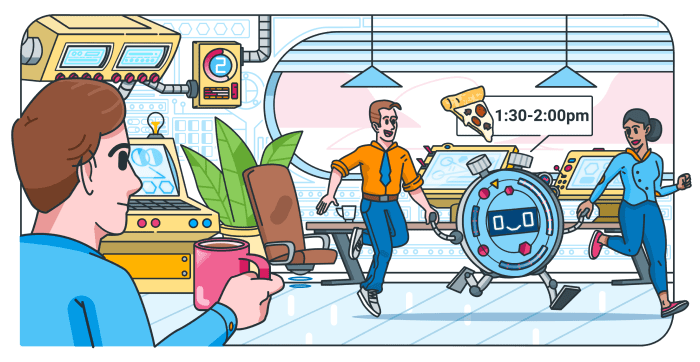
Table of contents:
The importance of time tracking
Work from home might as well become a reality for the greater population, considering how the Covid-19 pandemic suddenly shifted the landscape earlier in 2020. Stanford economist Nicholas Bloom saw this as a rising problem, saying it will “create a productivity disaster for firms”. It sounds ominous, but simple solutions, like time tracking, can cushion the blow.
It seems the remote work practice is here to stay, at least for a while. Which means that productivity will suffer, one way or another. There will be more overtime, overlaps with workforce management, time theft, wasted hours, and much more. And so, to avoid any productivity disasters, CEOs and employees together need to get used to tracking time.
Here at Clockify, we’ve compiled a list of reasons why you specifically should track time, and some methods to get you started.
Reasons to track time as an employer
When employers track time, they mostly do it for two reasons:
- Compensation, and
- Workforce management
First, we will discuss why tracking hours worked matters when it comes to paying your employees. Afterward, we will see how it helps with productivity, project management, workload management, etc.
Tracking time for salaries and overtime
The first big reason for time tracking is to provide fair compensation to employees with hourly wages. Let’s take a look at the importance of time tracking in this instance.
Paid time
Among different types of employee compensation (hourly, salaried, commissions, and bonuses), hourly is the one that demands time-tracking for financial purposes.
When your staff works by the hour, especially when you account for overtime and/or time off, it can be easy to lose track of who did what and for how long. And when they need to get paid, you want to be sure everyone is earning as much as they worked. Not to mention that, statistically, average working hours have shifted so much.
A free work hours tracker like Clockify can cover several bases here:
- It lets you define the hourly rates for each employee;
- The employees can enter their tasks in a timesheet for a clear daily overview;
- Track the time worked on a task with a timer, for precise calculation later;
- Track time consistently and daily, to ensure reliable data;
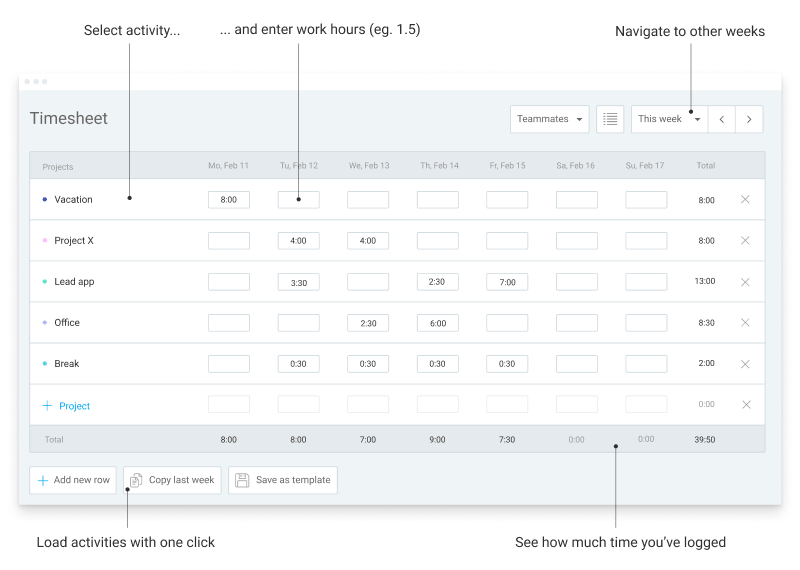
- Lastly, it automatically calculates the pay depending on the time period and the hourly rate you put in.

In this very simple way, your employees will keep a record of their hours worked, and you will have less trouble with payroll.
Overtime
Usually, hourly workers are also eligible for overtime pay or compensatory time.
With overtime pay, your state laws will dictate how much hourly wage per hour will increase for every hour spent in overtime.
With compensatory time, employees can decide to take time off in exchange for overtime hours, instead of additional pay.
- Overtime laws
For overtime pay, you or your employees must track the time spent working outside regular work hours. Without a “paper trail” on how much time was spent in overtime, there can be legal repercussions.
Depending on your country of operation, you should look into EU Time Tracking Law, California Overtime Law, or the US FLSA Working Time Regulation. Each outlines:
- Work hours per week;
- Maximum allowed overtime;
- Methods of documenting overtime;
- The number of hours per shift or day employees can work overtime, etc.
Time tracking is essential to keep a clean, legal trail of how much your employees work per day, week, or month. It makes sure you stay compliant with all the labor laws and regulations. And with the pandemic shaking up 2020, the US Department of Labor has updated their guide on employer obligations concerning time tracking.
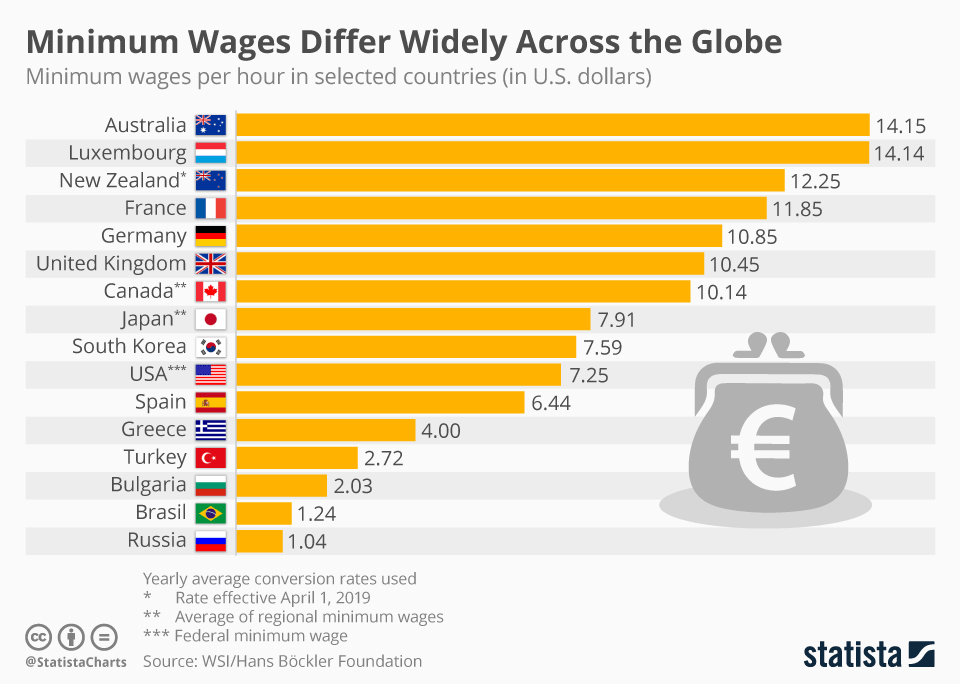
Source: statista.com
- Overtime rates
Without diverting too much from the topic, in short, overtime rates differ on a country-to-country basis, and on weekly and daily hours worked.
For example, California Overtime Law requires employers to pay 1.5 times the hourly wage during weekdays and on Saturdays. Depending on the contract with the employees and how many overtime hours they put in, the rates will differ.
- Compensatory time
Lastly, you can “pay” your employees in time off for their overtime hours. This is known as compensatory time, and various factors can influence whether or not an employee is eligible or not, and how it is calculated.
But even in that case, you will need a trustworthy time tracker to know how much time off the employee can get based on their overtime.
? More details on this topic can be found in our in-depth guide about compensatory time.
And if you need help finding the appropriate time tracking app, we have an extensive list with all the benefits each one brings.
Workforce management and other reasons for tracking time
Time tracking prevents violations
We’ve mentioned the various laws and regulations put in place to regulate how employees are compensated for their work time. However, the reason for them is not just to ensure you provide proper payroll, but that the companies themselves can avoid making any violations.
Employers can unknowingly make wage and hour violations. According to Tittle and Perlmuter agency, the most common ones include:
- Unpaid minimum wage
- Failing to pay for hours worked
- Misclassifying employees
- Miscalculated overtime
Penalties can range from paying the amount of missed wages to three times the amount, and from six months to a year.
The official site of the NCSL explains in more detail the violations and penalties for each state in the US.
Both time and wage violations can be prevented simply by tracking hours worked regularly and calculating payroll according to the data you collect.
Time tracking is necessary for employees taking time off
The Family and Medical Leave Act is an act that grants employees an unpaid (but job-secure) leave of absence of up to 12 weeks yearly. But, for an employee to be legible, they need to fulfill several requirements. The list includes having worked for their employer for 1,250 hours in the past 12 months, which equates to roughly 24 hours a week.
As you can see, tracking hours worked also helps in cases where employees want to take unpaid leave to care for family members, private responsibilities, health issues, etc. The responsibility of providing the proof falls on the employer so, without the necessary data, there can be a lot of backtracking and digging through archives.
Tracking hours prevents time theft
Time theft happens when an employee accepts pay for work hours they haven’t put in. This happens in several ways:
- Using leeways with flexible schedules (especially with remote work);
- Clocking in and out their coworkers, and not just themselves;
- Extended breaks;
- Browsing entertainment during work hours, etc.
Time theft is easily traceable and solvable after you’ve spent some time tracking employees’ hours. You will begin to notice patterns of behavior and address them accordingly.
Tracking time helps with making better work estimates
Much of a project’s (or a product’s) success, comes down to how well the company has handled the deadlines.
Ensuring a project stays on track, and doesn’t exceed the projected costs requires a lot of preparation and estimation. Teams make milestones and within them, smaller deadlines, to fit into a framework needed to produce a successful result. And once the work starts, time tracking becomes essential.
As the teams work, the software can help you realize where those estimates were wrong, and where they worked perfectly well. For example, an employee could take a day longer to finish a task, and unknowingly hobble their entire team for the next deadline.
But, at the same time, tracking hours worked within those estimates shows you dips in productivity. And like blips on a radar, when you register them, you can consult the teams to learn about the specific problems and fix them.
Time tracking in project estimates does wonders to identify problems early on, and lets you address them before the errors cost you too much time, energy, and money.
As they say – a stitch in time saves nine.
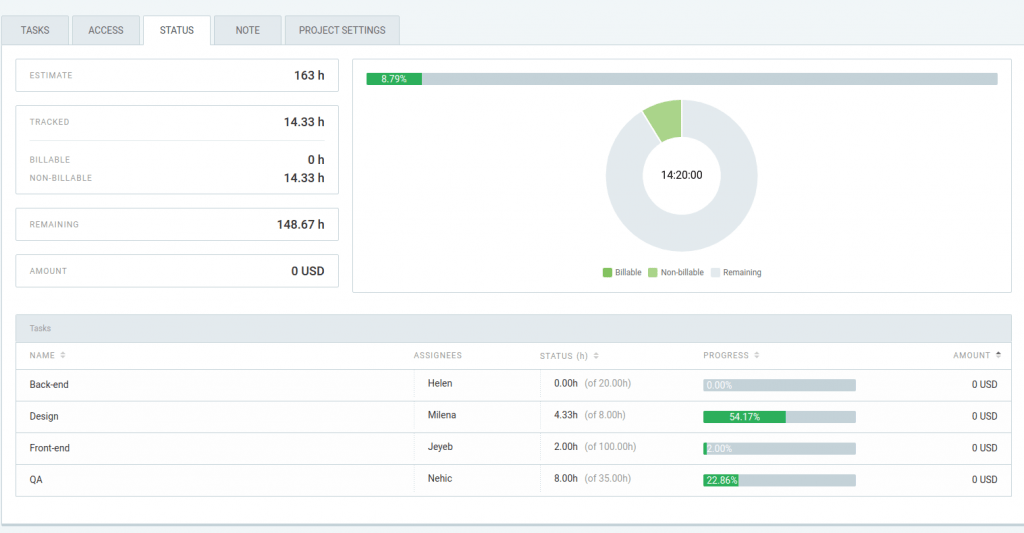
An example of tracking project estimates using Clockify
Tracking employee time lets you be a better manager
CEOs, project managers, managers overall, and even HR will want to get a better grip on workforce management.
When you track employees’ hours worked, you get a general overview of who does what in which department. While this can sound overwhelming, it also helps you understand how work is distributed across the company.
As tasks get checked off in the timesheets, you begin to notice which teams have too much on their plate and need some offloading, and which ones can take on more tasks.
In this case, time tracking helps you balance out the workload, so no one gets overworked or bored, while at the same time keeping up with milestones.
It identifies wasted time
Unlike time theft, wasted time is more concerned with the current state of the employees’ productivity and how it affects production/workflow.
Wasted time is a minor transgression where people begin to underperform, which results in missed deadlines and longer production time. While wasted time doesn’t affect your finances in the same way as time theft, it can be just as dangerous in the long run.
With time tracking to find where time is wasted and how much, an employee’s timesheet unlocks all the information you need: the breaks they take, the types of tasks they work on during different times of day, when they clock in and clock out, etc. It gives you an overview of where some people start to lose motivation, at what hour, or how often they take breaks and how long they last.
There are multiple reasons why people lose motivation in the workplace. And solving those issues takes more than time tracking.
But, it helps identify which individuals and teams alike need help, by providing the data needed to start with performance improvement.
? More on wasted time: How to identify wasted time and inefficiency
Reasons to track time as an employee
Of course, it’s not only employers and companies that reap the benefits of time tracking. Employees, freelancers, and independent contractors alike enjoy the same advantages it brings. The following list contains just some of the reasons why one should start tracking hours worked.
We also made a go-to page for 48 most commonly asked questions concerning work time and time tracking.
You can have a better work-life balance when you know where your time is wasted
Nicholas Bloom also mentioned how only half of their survey respondents from March 2020 said they could work efficiently from home. And it was mostly workers who do their jobs mainly on computers.
Not everyone is ready to adjust to remote work. However, when push comes to shove, you will want to do everything you can to adjust as seamlessly as possible.
Time tracking can help you avoid long evenings trapped at your computer, or starting work the moment you open your eyes because there’s no more commuting to the office. How many times have others interrupted you mid-work with personal matters? Whether it was children, the washing machine, a phone call from the family, or the neighbors?
If you track hours worked, you impose a sort of discipline and organization. Because as you fill out a timesheet, you begin to notice how much time goes to your actual work, especially when the distractions accumulate during the day. A time tracker can, in this way, set the base for you to plan out future days and set those much-needed boundaries.
Time tracking makes you better at contingency planning
Did you know that time tracking can actually help you make contingency plans? In some cases, tracing work hours can protect you from unfair treatment at work.
1. For unfairly increased workload
If you begin to notice that your employer has started to pile on more obligations, you can gather enough evidence just by time tracking those tasks. An archive of how many hours have been spent menial work is legitimate proof that your actual work has taken a back seat for tasks not in your job description.
2. Unpaid overtime
Similarly, if you’ve been pushed into overtime, but haven’t been compensated fairly, an account of your overtime hours is crucial if you want to negotiate with the employer or file for time and wage violation. Just keep in mind the conditions you need to fulfill to be eligible for overtime pay.
3. Eligibility for FMLA
In cases where you want to take unpaid leave with guaranteed job security, the Family and Medical Leave Act ensures you can do so. However, one of the conditions requires you have worked for your employer 1,250 hours in the past year. It comes down to roughly 24 hours a week.
In an FMLA court dispute, a school teacher wanted to take time off for mental health reasons. When he was rejected due to not fulfilling the required hours worked, he took the matter to court and asked for a revision. The school attorneys managed to prove that even with at-home work such as preparing lessons and grading papers, he couldn’t have amassed 1,250 hours. The appeal was rejected.
It’s important to know that companies will do what they can to keep clean records to protect themselves. Their employees might as well do the same.
4. Keeps you compensated fairly
Again, if you work on an hourly wage, tracking time will be the lifeblood of your workday. It’s an insurance that you get paid properly for the effort and energy invested. Of course, companies aren’t a necessary evil that is out to get you, but mistakes are made. Especially with remote work.
Keeping a separate account of your work hours can make for a good safety net. And if you already have a time tracker at work, fill it in as diligently and specifically as possible. Your future self will thank you for it.
Tracking the time you spend on tasks can help you better organize yourself
Needless to say, keeping track of hours worked makes a world of difference for your productivity.
It gives you that small push into feeling more in control of your time. Looking at your timesheet at the end of the day, it’s easier to spot where you were at your most productive, or where things could have gone better.
This kind of self-reflection is key to becoming more productive, especially today.
Analyzing your mistakes and improving upon them the next time you start filling out the timesheet gets you one step closer to a stress-free workday. At least on the organizational side.
Using a team timesheet app lets your coworkers know not to bother you
Now, whether you work remotely or not, we can all agree that emails and chat messages from coworkers and managers can take up a lot of our time. Especially if they’re to ask us how far we are with our tasks, or if we have some information they need, etc.
Now, when you use a team time tracker, you can prevent some of these distractions by letting them know early on that your availability depends on the task listed on your timesheet.
For example, in Clockify, team members can see each other’s ongoing and completed tasks. So, when a coworker opens that specific page, they can see what you are working on at the moment. By using specific labels, you can easily denote how urgent a task is, or simply add in a note in the task. For example: “Need full focus, please do not disturb”.
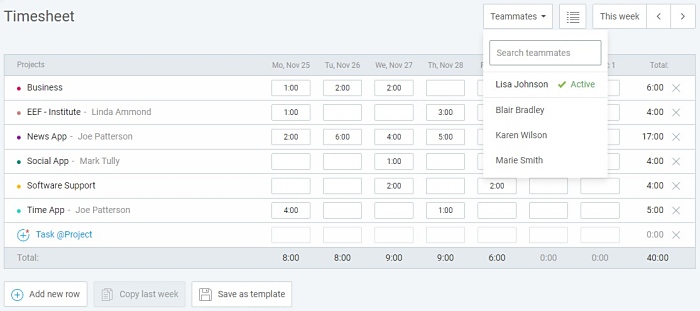
In Clockify, you can easily look up coworkers in your workspace, to see their tasks.
Final thoughts
The reasons for tracking time are multiple. As we’ve mentioned in the beginning, the landscape of work has changed so dramatically, we need to rely on as much data as we can collect. Especially if we transition to mostly remote work. Time tracking is one of the most trustworthy methods of maintaining work stability. It helps organize work, identify problem points, provides information on the time employees and employers alike spend throughout the workday.
Time tracking is an indispensable work tool that stood the test of time, and it’s the most versatile weapon we have for surviving in the modern workplace.





